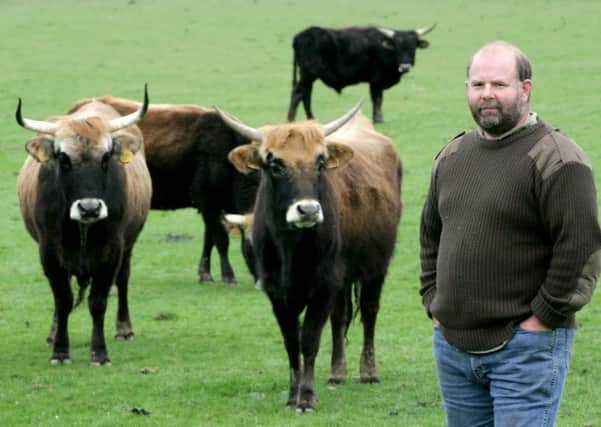Farmer forced to dump ‘aggressive’ Nazi-bred cows


The aurochs were brought back to life by Adolf Hitler’s researchers in the 1930s after officially dying out 4,000 years ago.
They arrived in Britain for the first time in 2009 when farmer Derek Gow imported 13 “Heck” cattle from Belgium to his Upcott Grange Farm in Devon.
Advertisement
Hide AdAdvertisement
Hide AdIt was the first time the creatures had set foot on British soil since the Bronze Age.
But Mr Gow, 49, has now been forced to get rid of seven of the cows as he could not handle their “incredibly aggressive” nature.
He said: “We have had to cut our herd down to six because some of them were incredibly aggressive and we just couldn’t handle them.
“What the Germans did with their breeding programme was create something truly primeval.”
Hitler saw the super cows as a symbol of German and Aryan might and tasked leading geneticists, brothers Heinz and Lutz Heck, to bring the Aurochs “back into existence”.
The pair traced the species’ descendents to domestic breeds and managed to “pull the wild genes out” in a Jurassic Park-style experiment.
The Heck’s programme at zoos in Berlin and Munich was so successful that the new Aurochs flourished and were used in propaganda material during World War Two.
Father-of-two Derek says they were shorter than the aurochs, but retain their ancestors’ muscular build, deep brown complexion, and shaggy coffee-coloured fringe.
CONNECT WITH THE SCOTSMAN
Advertisement
Hide AdAdvertisement
Hide Ad• Subscribe to our daily newsletter (requires registration) and get the latest news, sport and business headlines delivered to your inbox every morning
He added: “Importing the cattle has been an interesting project for us - they have such an unusual history.
“There was a thinking around that time that you could selectively breed animals for Aryan characteristics, which were rooted in runes, folklore and legend.
“Heck cattle were the product of an attempt to back-breed using a number of existing older species, including Spanish fighting bulls, Fresians and Simmentals.”
The cattle, which have lethal-looking horns and a muscular build, are unlike any modern commercial breed of cow.
They were almost destroyed following the defeat of Nazism in 1945, but some survived after they were shipped to game parks in Western Europe.
Mr Gow said: “As far as being a commercial breed is concerned, they have little value, but they are a significant animal from a conservation point of view.
“For instance, each cow can produce its own weight in dung every year, which is a great source of food for insects and bugs and nutrients for the environment.
Advertisement
Hide AdAdvertisement
Hide Ad“The auroch was extinct, but domestic descendants - Friesians, Simmentals and everything else - were still kicking around the countryside.
“The two brothers argued that if the one wild animal that spawned all of these had gone, through a process of back-breeding domestic cattle, you could pull the wild genes out and recreate the ancestor.
“Between the two wars, there was a thinking that you could selectively breed animals - and indeed people - for Aryan characteristics, for characteristics that were rooted in runes, folklore and legend.”
The half-tonne cattle, referred to formally as Bos primigenius, died out in Britain 4,000 years ago but remained widespread across much of Europe until the 1600s.
But they were finally wiped out in 1627 after they were hunted to extinction for their horns, hide and meat.
They were saved in the early 1930s when Hitler wanted to recreate the breed to evoke the power of the “runes, folklore and legends of the Germanic peoples”.
Heinz and Lutz Heck found their descendants in a cattle from the Scottish Highlands, Corsica and the French Camargue, as well as Spanish fighting bulls.
They then identified the particular auroch gene, which they were able to use to bring them back from extinction.
Advertisement
Hide AdAdvertisement
Hide AdThe cows were later transported to game parks in Schorfheide near Berlin, and the Neander Valley in Dusseldorf.
Derek said: “The aurochs were wild bulls. Julius Caesar recorded them as being bulls as big as elephants.
“Young men hunted these bulls as preparation for battle and leadership in war, but also to obtain these huge 6ft-wide horns that the bulls had as drinking vessels and war horns. They were huge trophies.”
SEE ALSO
SCOTSMAN TABLET AND IPHONE APPS